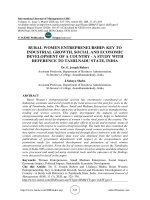Economic growth and economic development 683
Bạn đang xem bản rút gọn của tài liệu. Xem và tải ngay bản đầy đủ của tài liệu tại đây (115.64 KB, 1 trang )
Introduction to Modern Economic Growth
and
η H VH (t) ≤ 1 and η H VH (t) = 1 if ZH (t) > 0.
(15.21)
Finally, the consumer side is characterized by the same necessary conditions as usual:
1
C˙ (t)
= (r (t) − ρ) ,
C (t)
(15.22)
and
(15.23)
à Z t
ả
á
r (s) ds (NL (t) VL (t) + NH (t) VH (t)) = 0,
lim exp −
t→∞
0
which uses the fact that NL (t) VL (t) + NH (t) VH (t) is the total value of corporate
assets in this economy.
We are now in a position to characterize a balanced growth path (BGP) equilibrium. Let us define the BGP equilibrium to be one in which consumption grows
at the constant rate, g∗ , and the relative price p (t) is constant. From (15.10) this
implies that pL (t) and pH (t) are also constant.
Let VL and VH be the BGP net present discounted values of new innovations in
the two sectors. Then (15.9) implies that
1/β
(15.24)
VL =
1/β
βpL L
βpH H
and
V
=
,
H
r∗
r∗
where r∗ is the BGP interest rate, while pL and pH are the BGP prices of the two
intermediate goods. The comparison of these two values is of crucial importance.
As discussed intuitively above, the greater is VH relative to VL , the greater are the
incentives to develop H-complementary machines, NH , rather than NL . Taking the
ratio of these two expressions, we obtain
à ả 1
H
pH
VH
=
.
VL
pL
L
This expression highlights the two effects on the direction of technological change
discussed in Section 15.1.
(1) The price effect manifests itself because VH /VL is increasing in pH /pL . The
greater is this relative price, the greater are the incentives to invent technologies complementing the H factor. Since goods produced by relatively
669









